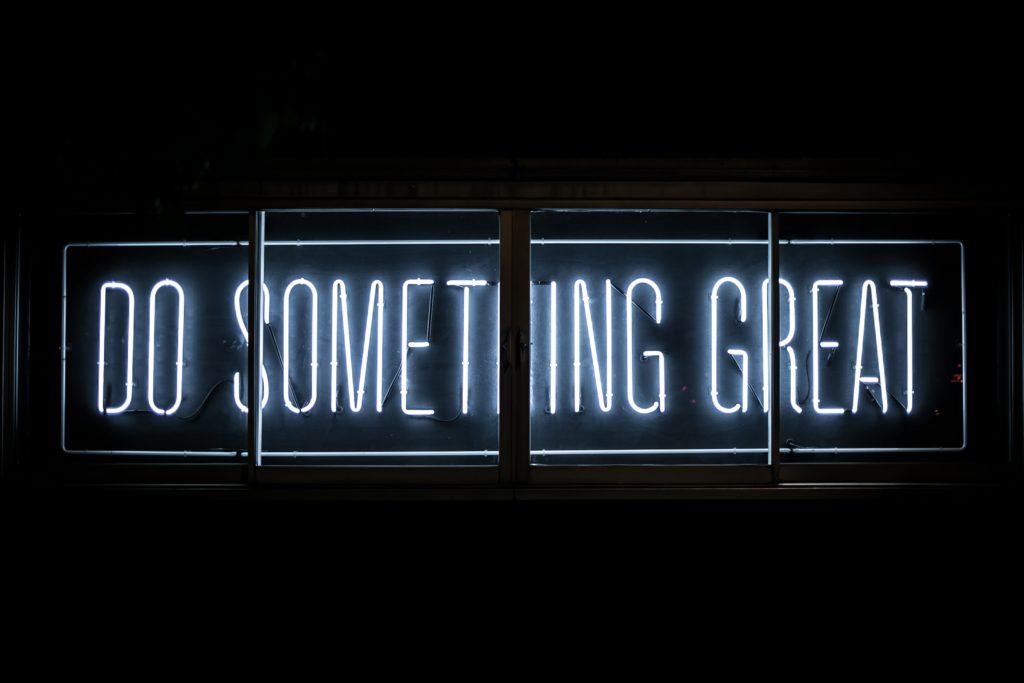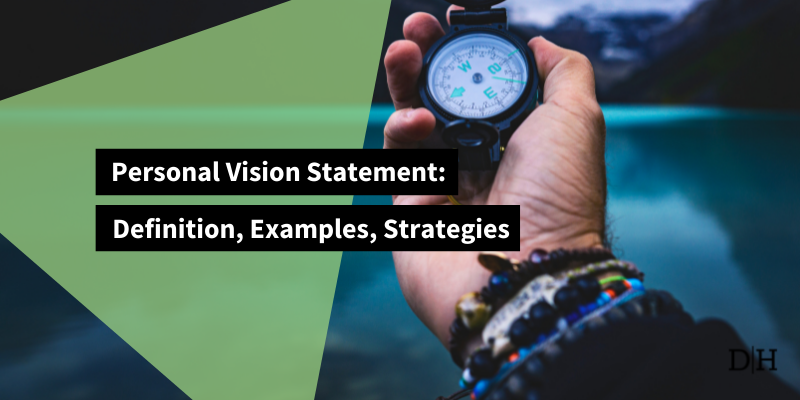Having direction is one of the key ingredients to success in life. But while most people understand it, only 14% of people actually have a plan in mind that they follow.
And unsurprisingly, that 14% is up to ten times more successful than the vast majority of people that don’t set goals and try to accomplish them.
But at the same time, setting just any goals isn’t very practical as well. You can spend years working towards something only to realize that it doesn’t align with who you want to be and the mark you want to leave in the world.
Luckily, that’s where a personal vision statement can be very useful.
It’s the perfect way to crystalize the core goals and values you want your life to represent, helping you put together a simple but accurate roadmap of where you want to go.
But what a vision statement, anyway? And how can it help you?
Let’s answer these questions and also explore some personal vision statement examples.
What is a Personal Vision Statement?
A personal vision statement is a statement of your main goals in life. It can include both personal and professional goals, accomplishments, and values that you aspire to, all of which combine to create a guide map of where you want to get to.
However, since these types of statements are actually less common than those made by companies, things can be a bit more confusing. But in essence, there’s little difference between business mission statements and one that you’d create for your own life.
The main difference is that for businesses, the goals will usually relate to company-wide achievements. These achievements can be directly related to profits or business goals, but they can also be broader and encompass the company’s aspirations to change the world for the better.
The same can be said about personal vision statements as well.
On one hand, you can and should focus on your career goals, listing who you want to become and what you want to achieve once you get there. But at the same time, you want to look beyond career goals and think of them in terms of how they can help you realize yourself as a person, leaving a mark on the world while remaining aligned with the values that matter to you.
The process of listing your goals and aspirations may seem simple and even redundant. After all, most people already know what they stand for and what they want, right?
Well, the truth is that words put on paper (or in a word processor) with intention have a lot of power. And that’s what we’ll explore in the next section.
Why Does It Matter?
Staying on top of your goals and aspirations isn’t easy. Life gets in the way, you have to change course, and getting back on track isn’t always as simple as it can seem from the outside.
But even though it’s not easy, there are ways how you can at least make it a bit easier. And one of those ways is using personal vision statement examples as a guide for your decisions.
Let’s explore a few of the main ways it can help you.
Crystalize Your Priorities
Achieving ambitious goals isn’t easy. In fact, achieving any goals isn’t easy if they require effort and consistency. Often, it requires you to make decisions that you won’t want to make and do things that make you uncomfortable.
The good news is that if you use a personal vision statement as your guide, you can at least make a stronger case for yourself why all that effort matters.
When faced with a tough decision, you can look back at your vision and know which choice gets you closer to those ultimate goals. And if those goals really matter to you (which they should if your personal vision statement is done right), you will usually have no problem following through despite all of the challenges.
In my program, Managing Happiness, one of the biggest areas of focus is helping people figure out what they should prioritize. In the program, I help people define their vision and core values, exchange ideas with peers, and find the inner motivation to move forward.
Inspire You to Take Action

Humans are naturally inclined to strive for comfort. And without self-reflection, that inclination can quickly turn to complacency and a lack of action in the most critical areas of your life.
But if you have a clear vision of what you want to achieve and crystalize that vision into specific aspirations, you might actually find yourself itching to get as much done as possible, eliminating all distractions because of the sheer excitement that your mission creates.
The best personal vision statement examples aren’t afraid to dream big and portray the best versions of the people they were written by. If you can create one like that, it can be a huge inspiration that helps you stay motivated.
In the How We Solve Podcast, Catherine Arnston shares her story of starting a company in a market that didn’t exist, and it’s a great example of not being afraid to set grand goals. When you know your “why?”, everything else is just a matter of taking action and putting enough effort. And a personal vision statement can help you get through that.
Push Through Difficult Challenges
Finally, you need a personal mission statement to remain focused and determined when faced with various obstacles that are sure to arise in life.
When that happens, you’ll need all the motivation you can get to stay proactive, and coming back to the very core of your values will be the guide that shows you what really matters and puts any shortcomings or failures into perspective.
The small victories and defeats are stepping stones towards what you will eventually achieve. But having that end result written out is much better than only having it as a vague idea in your head.
How to Write a Personal Vision Statement?
Now that we’ve established why good personal vision statement examples are so powerful, we need to answer the next essential question:
How can you actually write one?
When you’re staring at a blank screen and need to lay out your life’s vision, it’s easy to become stuck. But if you take a structured approach, you can usually get it done in less than an hour.
Let’s break down the steps involved in the process below.
Consider Your Strengths
Most people gravitate towards things they are naturally good at. Therefore, starting with your strengths is a great way to get the ball rolling if you want to start looking at the things you want to achieve.
Now, that doesn’t mean that you can only strive for accomplishments that align with what you do right now, but you may find that your strengths can still help get you where you need to go.
List all of your strengths and skills without worrying about their order or whether they all matter. When you’re writing the actual personal vision statement, you can use this list to guide what to include and what to emphasize.
Highlight Your Values

Strengths and skills are essential, but only as long as they align with the values that you want to represent. Therefore, the next step when creating a vision statement is listing the beliefs that define you and matter to you.
Ideally, try to find values that reflect how you want to be perceived or what you want to achieve. Do you want your work or achievements to contribute to society? Do you want to have the freedom to pursue your passions and hobbies? Or would you like to become a leader and a role model to others?
These things can be a significant motivator and the basis for your personal vision statement, so thinking through how your values relate to your goals is a great way to connect the dots.
Identify Career or Business Goals
Even though a personal mission statement can cover many aspects of your life, it should include career and/or business goals since that’s likely a big part of how you want to fulfill your purpose.
What’s more, focusing on the career path you want to take will allow you to pursue work that actually makes you happy. Having a passion for your job is a great position to be in, but you need to combine your big-picture goals with the work you want to do to be truly satisfied.
Achieving professional success requires a lot of hard work and commitment, so you should take the time to write out your goals to ensure that they will actually make you happy once you achieve them.
Put Everything Together
Finally, once you have your strengths, values, and career goals, you can start using bits and pieces from all three to create your personal vision statement.
Keep in mind that a personal mission statement must not be much longer than 50 words for it to be effective. Some people even try to fit it into a single sentence. That’s because you will be reading it every day (or at least frequently), so you want it to be punchy, short, and to the point.
To keep things simple:
- Start with the career you want to have, describing it in one short sentence.
- Base that on the strengths that you have and the way you want to contribute to the world.
- Add another sentence that briefly expands on how your career and personal goals will contribute to others or the causes you’re passionate about.
Personal Vision Statement Examples
At this point, you are almost ready to create your own personal vision statement that reflects who you are and what you want to achieve. To give you some inspiration, you can take a look at the personal vision statement examples below.
These are simple illustrations of how the statement might look. But keep in mind, copying someone else’s personal vision won’t make it useful. If you want to draw inspiration from it every day, it must come from within and describe the mission that’s right just for you.
- “My goal is to become a CEO at X company. I want to become an ethical leader and realize my vision of how the company should be run and help create a more sustainable and inclusive environment that will propel the company’s growth.”
- “I want to become a career counselor that helps people discover their true purpose and a job that’s aligned with their goals and passions. My ultimate purpose is to give people the tools and confidence they need to pursue their dreams, realizing the full potential they have.”
- My goal is to start my own baking business where I sell vegan pastries. I believe in a world that’s free of animal cruelty and land exploitation, so my purpose is to create a sustainable and environmentally business that brings people together and brings attention to the cause.
- I want to build a tech company that helps businesses connect with their best customers. I believe that marketing can be ethical and transparent and want to create a marketing tool that makes it possible to attract leads without compromising on user data privacy.”
- My ultimate goal is to launch a successful company and become financially independent. I want to dedicate my time to helping the less fortunate, discovering cultures around the world, and meeting people that help me grow and understand life on a deeper level.”
These are just a few examples of how different people might see their personal vision. And while you do need to come up with one that’s unique to you, don’t be afraid to put something on paper right now, in the next hour.
As you grow and learn new things, you can always tweak your mission statement and make it better. But it all has to start with something.
Bottom Line
Creating a personal vision statement can be a great way to crystalize what really matters to you and what you want to accomplish. And while the task can seem daunting at first, by breaking it down into actionable steps, you can usually put down an actionable statement in less than an hour.
How are you using a personal vision statement in your personal or professional life? And what are some of the best personal vision statement examples you have found? Share in the comments below!




